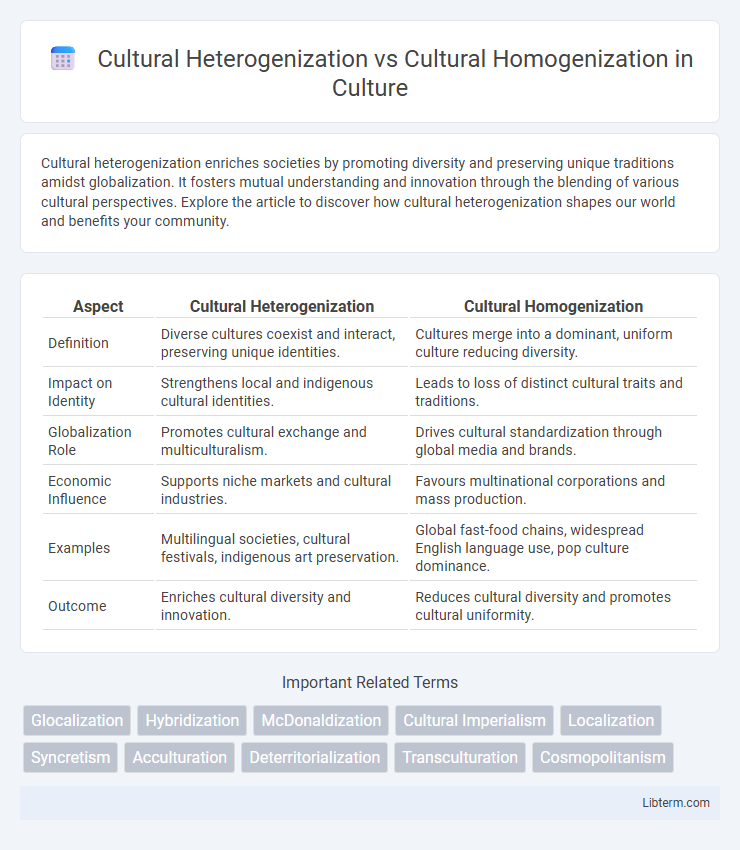Cultural heterogenization enriches societies by promoting diversity and preserving unique traditions amidst globalization. It fosters mutual understanding and innovation through the blending of various cultural perspectives. Explore the article to discover how cultural heterogenization shapes our world and benefits your community.
Table of Comparison
| Aspect | Cultural Heterogenization | Cultural Homogenization |
|---|---|---|
| Definition | Diverse cultures coexist and interact, preserving unique identities. | Cultures merge into a dominant, uniform culture reducing diversity. |
| Impact on Identity | Strengthens local and indigenous cultural identities. | Leads to loss of distinct cultural traits and traditions. |
| Globalization Role | Promotes cultural exchange and multiculturalism. | Drives cultural standardization through global media and brands. |
| Economic Influence | Supports niche markets and cultural industries. | Favours multinational corporations and mass production. |
| Examples | Multilingual societies, cultural festivals, indigenous art preservation. | Global fast-food chains, widespread English language use, pop culture dominance. |
| Outcome | Enriches cultural diversity and innovation. | Reduces cultural diversity and promotes cultural uniformity. |
Understanding Cultural Heterogenization and Homogenization
Cultural heterogenization refers to the process where diverse cultural groups maintain or intensify their unique identities despite global influences, promoting multiculturalism and cultural diversity. Cultural homogenization involves the blending or erasure of distinct cultural differences, often driven by globalization, leading to more uniform practices, languages, and values across societies. Understanding these concepts highlights the dynamic tension between preserving cultural uniqueness and the tendency for global cultures to converge into a standardized form.
Historical Context: Roots of Cultural Exchange
Cultural heterogenization and cultural homogenization trace their roots to historical patterns of trade, migration, and colonization that facilitated extensive cultural exchange and interaction. The Silk Road and Age of Exploration illustrate how diverse societies transmitted knowledge, customs, and technologies, leading to the blending or preservation of distinct cultural identities. This complex historical context reveals how globalization processes have alternately promoted cultural diversity and uniformity across regions.
Globalization: Catalyst for Homogenization
Globalization acts as a catalyst for cultural homogenization by promoting the widespread diffusion of dominant cultural elements such as language, consumer brands, and media content across borders. This process diminishes cultural heterogenization by standardizing lifestyles and values, leading to increased similarities among diverse societies worldwide. Multinational corporations and digital platforms play pivotal roles in accelerating cultural convergence, often at the expense of local traditions and identities.
The Role of Media in Shaping Cultural Identity
Media plays a pivotal role in cultural heterogenization by promoting diverse narratives and local content that reinforce unique cultural identities worldwide. Simultaneously, global media conglomerates drive cultural homogenization by disseminating standardized entertainment and consumer values that blur distinct cultural boundaries. The interplay between these forces shapes cultural identity by balancing global influences with the preservation of local traditions and languages.
Cultural Resistance and Preservation Movements
Cultural heterogenization sparks cultural resistance and preservation movements that actively challenge the dominance of globalized cultural norms, fostering the protection of indigenous languages, traditions, and identities. These movements leverage local art, education, and community rituals to sustain cultural diversity and counteract cultural homogenization driven by media and consumerism. Efforts in regions such as Latin America, Africa, and Southeast Asia highlight the resilience of marginalized cultures in maintaining their heritage amidst globalization pressures.
Economic Forces Driving Cultural Change
Economic forces driving cultural change include globalization, which promotes cultural homogenization by spreading multinational corporations, consumer products, and media content across borders. Conversely, local economies and niche markets fuel cultural heterogenization by supporting indigenous industries, traditional crafts, and region-specific consumption patterns. Trade policies, foreign investments, and technological advancements further accelerate the tension between global economic integration and the preservation of cultural diversity.
Cultural Hybridization: Blending vs. Uniformity
Cultural hybridization emphasizes the blending of diverse cultural elements, creating new, dynamic identities that resist uniformity. This process contrasts sharply with cultural homogenization, which promotes a global standardization of cultural expressions and practices. Hybridization fosters innovation and diversity through the continuous interaction of local and global influences, resulting in unique, hybrid cultural forms.
Social Consequences of Homogenized Cultures
Cultural homogenization often leads to the erosion of local traditions, languages, and identities, resulting in diminished cultural diversity globally. The widespread adoption of dominant cultural norms can create social alienation and weaken community bonds, as unique cultural practices and values become marginalized. This uniformity can also fuel social tensions by undermining minority groups' sense of belonging and cultural pride.
Case Studies: Heterogenization Around the World
Case studies of cultural heterogenization illustrate how local traditions and customs adapt uniquely to global influences, preserving cultural diversity across regions such as India's Bollywood industry blending Western techniques with indigenous storytelling. In Japan, the integration of global fashion trends into traditional attire exemplifies hybrid cultural expressions that resist homogenization. Similarly, Latin America's retention and revival of indigenous languages and festivals amidst globalization underscore a dynamic interplay between global connectivity and local identity maintenance.
Future Trends: Balancing Diversity and Unity
Future trends in cultural heterogenization emphasize the growing importance of preserving unique ethnic identities and languages amid globalization pressures. Simultaneously, cultural homogenization advances through widespread digital connectivity and mass media, fostering shared global values and practices. The challenge lies in balancing cultural diversity with unity, leveraging technology to promote intercultural dialogue while safeguarding local traditions.
Cultural Heterogenization Infographic

 libterm.com
libterm.com